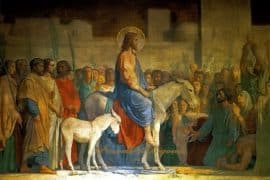Gary Greenberg was kind enough to send me a copy of his fascinating new book, Proving Jesus’ Authority in Mark and John: Overlooked Evidence of a Synoptic Relationship (Cambridge Scholars Publishing, 2018). I am just beginning to read it, so I will not attempt any kind of overview or review at this point, but the book has inspired me to begin a series of posts on “Reading Mark and John Side by Side.”
Most critical biblical scholars are in agreement that Mark is our earliest gospel and John is the latest. It is also generally held that Matthew and Luke, that are written after Mark but before John, are using Mark as their basic narrative source–thus the three of them, Mark, Matthew, and Luke, are called the Synoptic gospels. In other words, Matthew and Luke are “secondary” sources when they are following Mark, in that they, by and large, are recasting or interpreting Mark as their base text. One could even say that Matthew and Luke are “rewritten Mark,” in that 80% of Mark ends up in Matthew and 65% in Luke–and both follow Mark’s basic order and structure. This is not to say that Matthew and Luke have nothing to add to the historical Jesus tradition. Indeed they do. They both contain just over 200 verses in common, none of which are found in Mark. Most scholars argue that this parallel material that Matthew and Luke share is based on their independent use of a “Sayings” source, now lost to us, that is know as Q, from the German word Quelle that means “source.” This is called the “Two Source” hypothesis–namely that Matthew and Luke largely drew upon Mark and this lost source known as Q in composing their works. Other scholars, such as Mark Goodacre, believe that this non-Markan material is best explained as a result of Luke using Matthew as a source. You can read Goodacre’s main arguments summarized at his web site “The Case Against Q.” In addition Matthew, and especially Luke, contain additional materials that are unique to each of them.

John, in contrast, is usually seen as a mostly independent witness to the Jesus tradition, with an approach that seems in sharp contrast to Mark (or the Synoptics more generally). His stories are different, his chronology is different, and the Jesus of John’s tradition speaks with a different vocabulary and subject matter. To put it most simply–he just “sounds” different! Compare the extended dialogues and speeches of Jesus (the Red Letter material in some Christian Bibles) that runs through John 14-17, or even earlier in chapters 5-10. The style in which Jesus speaks, and especially the vocabulary he uses, as James Dunn has demonstrated, is closer to the author of the letter we know as 1 John than the Jesus we know in the Gospel of Mark. In Mark Jesus primarily speaks of the “Kingdom of God,” whereas in John the Kingdom of God is hardly mentioned. Instead one finds Jesus constantly speaking in the first person about himself, his work, and his authority (See his Evidence for Jesus (Westminster: John Knox, 1986), pp. 30-50).
Further, Jesus is viewed much more explicitly in John as a preexistent, heavenly, divine, Son of God who descended from heaven and has now ascended back to the Father. John lacks any exorcism stories,parables, or pithy epigrams, that are such a core part of Mark’s gospel. One might assume then, and many historians have taken just this approach, that John is of little value in reconstructing a critical historical view of Jesus.
It is an open question as to whether John knew or had any literary relationship to Mark, or more generally, to the Synoptic gospels. Some scholars have argued that he might have known of oral traditions that end up in our version of John but few believe there is any direct literary relationship. This is where Greenberg’s book comes in. He is convinced that John knew a written version of Mark’s gospel, or at least a written source used by Mark, and that he had “deep and profound objections” to the content of Mark. Greenberg argues that John is in fact using Mark as a structural outline but providing alternative narratives that undermine Mark’s understanding of Jesus and his teachings.
Regardless of the literary relationship of these two gospels, I am among a growing group of scholars who are convinced that John in fact preserves a level of primitive tradition that Mark knows little about, and that without John’s contribution, our knowledge of the historical Jesus would be seriously lacking. I have in mind here the mass of research presented over the past 15 years in the “John, Jesus, and History” Group at the annual meeting of the Society of Biblical Literature. You can find a summary here. On Mark and John more specifically see Paul Anderson’s summary of his “Bi-Optic Hypothesis” here. My own contribution on the “geography” of John in the light of archaeology you can access on my web site, “Wadi el-Yabis and the Elijah Wadi Cherith traditions in Relationship to John and Jesus in the Gospel of John.”
The point should also be made clear that it is demonstrably false to assume that Mark is somehow free of theology and is writing history. In fact, Mark is every bit as “theological” as John, and I am thoroughly convinced that he shares a view of Jesus that is highly influenced by Paul, see my book, Paul and Jesus (Simon & Schuster, 2012).
So what is the historian, interested more in Jesus as a historical figure, to make of these different sources?
My own method and approach is to use Mark and John together to construct what I think is a coherent and plausible portrait of Jesus as apocalyptic messiah and proclaimer of the Kingdom of God, set in the context of the Baptist movement in 1st century Roman Palestine. I am further convinced, with Greenberg, that John likely knows Mark and is at times offering his own take on Mark’s presentation of Jesus, which he sees as supplementary rather than contradictory.
In my previous post “In Memory of Her,”I showed how Mark’s account of the unnamed woman who anointed Jesus before his death is supplemented by the different account int he gospel of John. Reading Mark and John together can often result in a composite account of an underlying set of traditions that sheds valuable light on what we know as a whole. I will explore some of the results of such a comparison in several upcoming posts.




![How James [Yaaqov], Beloved Brother of Jesus, Was Written out of Early Christianity](https://jamestabor.com/wp-content/uploads/2023/05/James-Pathway-270x180.jpg)




Comments are closed.